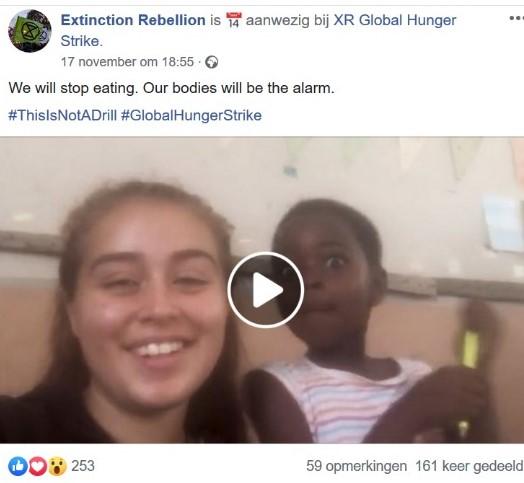
Extinction Rebellion's Global Hunger Strike
Since the 18th of November, Extinction Rebellion (or XR), an activist movement that wants to raise awareness on climate change and urge governments to take action, organized a global hunger strike. The movement is controversial: they are accused of being too radical, thereby damaging instead of improving public opinion on climate change because of their frightening message.
In this article, the message and organization of the XR Global Hunger Strike will be analyzed by looking at the use of the Extinction Rebellion Facebook page. First, the rise of XR and their goals will be introduced. Next, the message and organization of the global hunger strike will be analyzed using a digital ethnography approach
What is Extinction Rebellion and what do they want?
Extinction Rebellion is, in their own words, "an international movement that uses non-violent civil disobedience in an attempt to halt mass extinction and minimise the risk of social collapse". It all started in a small town in the UK, where fifteen people who had researched how to achieve radical change gathered. They started giving talks around the UK to share why they thought climate change is an urgent problem and what they propose as a solution: mass civil disobedience (Rebellion, 2019).
XR believes that because governments have failed to take action concerning the dangers of climate change, the people are entitled to mass civil disobedience.
The movement is called "Extinction Rebellion" because they truly believe that with our current way of living, huamnity is headed towards extinction due to climate change and biodiversity loss. XR is of the opinion that, although scientists have issued a warning over 20 years ago, governments have failed to act upon this knowledge. This is why they are in open rebellion against those in power, which started with their Declaration of Rebellion against the UK government. XR believes that because governments have failed to take action concerning the dangers of climate change, the people are entitled to mass civil disobedience. It is also important to them that their protests are non-violent. In their actions, they occupy important places and try to disrupt daily life in order to get the attention of governments. Even getting arrested is part of their goal as it would show that they are willing to sacrifice their freedom to get their message across.
In getting governments to take action in this crisis, they have three demands:
- Tell the truth: governments must tell the truth by declaring a climate and ecological emergency, working with other institutes to communicate the urgency for change.
- Act now: governments must act now to halt biodiversity loss and reduce greenhouse gas emissions to net zero by 2025.
- Beyond politics: governments must create and be led by the decisions of a Citizens’ Assembly on climate and ecological justice.
The XR Global Hunger Strike
Extinction Rebellion has organized all sorts of actions to raise awareness and to get governments to take action. From the 18th of November onwards, they have organized the XR Global Hunger Strike. Anybody who wanted to participate could do so, in various ways. The goal was to get governments to take action and to raise awareness for one of the consequences of global warming: food shortages.

Announcement Global Hunger Strike XR
On the 13th of November, a post announcing the global hunger strike was posted on the XR Facebook page. It quickly became the most shared, commented and liked post of the entire hunger strike campaign, garnering 492 reactions, 277 shares and 649 likes, which were mostly conventional Facebook likes, along with heart- and sad reactions. Considering that theirs is a global page with over 350.000 followers, these numbers were not a lot.
The post announced that over 100 XR rebels would participate in the Global Hunger Strike and would starve themselves for various amounts of time. It’s highlighted in the post that this is a last resort tactic for averting a devastating crisis: “They are employing this last resort tactic after more than three decades of petitions, protests and campaigns have failed to secure the urgently needed responses to mitigate ecological and climate breakdown, and social collapse”.
This is not only conveyed through words, but also through the use of emoticons. The skull emoticon is used when talking about the amount of people who are currently dying of starvation. The shocked emoticon, the alarm emoticon and the hourglass emoticon also all add to the message of urgency and danger.
XR is very clear about the issue they address. In all the paragraphs of this first post except the penultimate one, they mention the issue: we are in a planetary crisis and governments are refusing to take action.
The image of Extinction Rebellion is, at least in this post, not a visual one. Their image here was communicated through style. They used strong words like “hell”, “breakdown”, “crisis” and “abandoned” to describe the issue. The use of strong words is part of their style and in line with their message of urgency and danger.
The post ended with a quote from somebody who would be participating in the hunger strike. The quote made the post more personal and was at the same time in line with the message: "We will stop eating. Our bodies will be their alarm". The use of the voice of individuals who agree with the message was thus construed as being part of the image of XR. This was a consistent strategy throughout the whole campaign, as becomes evident when studying subsequent posts.
This course of action arguably fits well with the overall message they try to deliver: drastic methods are necessary when arguing for drastic change.
Hunger strike is a drastic strategy for getting attention. This course of action arguably fits well with the overall message they try to deliver: drastic methods are necessary when arguing for drastic change. As a movement with non-violence and citizen disobedience as its core principles, this seems like a drastic method which suits their identity.
The response
As messages are created in interaction (Silverstein, 2003), it is also necessary to look at the reactions of people to the post. While there were people who were supportive and commented things like “Brave” or “Good luck rebels. Supporting you all the way”, most reactions were negative.
Some people who do support the ideas of XR think this is not the right course of action for them, while others are critical of the movement as a whole. XR tried, by responding, to explain to the people who do support their ideas but not this particular action why they think this action will be effective and they asked for their support despite their difference in opinion. Although the XR Global Hunger Strike seems to fit well with the core principles of the movement, a lot of people don’t seem to agree with the drastic method.
XR also engaged with the people who are against XR as a movement altogether and called them out when they said something that XR deemed false while they also tried to clarify their message.
Interestingly, there were also some people who felt that the toxic comment section is a reflection of what the movement is like in real life, which makes them not want to join XR. XR reacted to this too by saying that "these pages are not a true reflection of us". It seems that the way people respond to these posts changes the way others look at the movement. The message is indeed formed in dialogue.
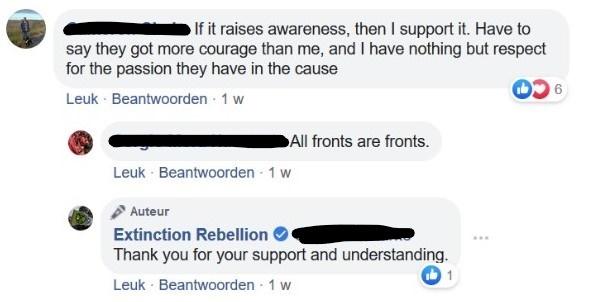
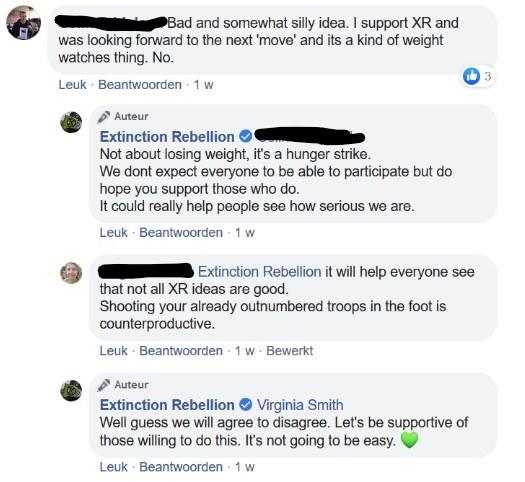
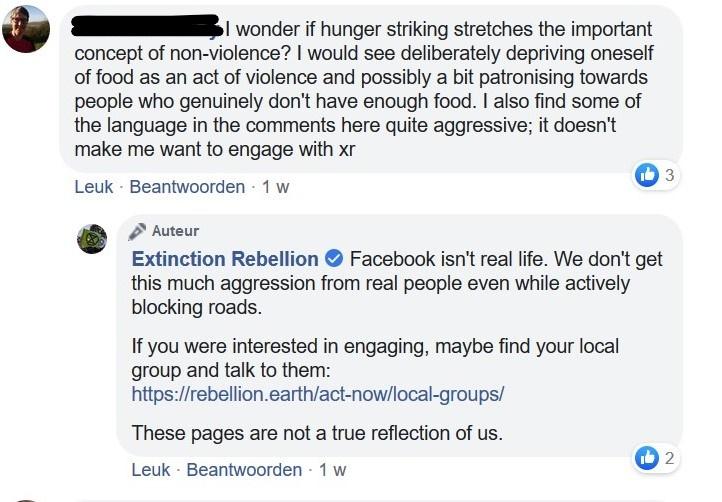
Algorithmic activism
The goal of Extinction Rebellion is to raise awareness for the climate crisis they think is occurring. They do this by organizing various campaigns, like the XR Global Hunger Strike. In the post announcing this action, they delivered a message of urgency and danger. In order to spread this message, they will want to reach as many people as possible. But how do they go about this? Do they understand the affordances of Facebook and do they use it for algorithmic activism?
In the first post announcing the hunger strike, a few things are noteworthy. It is a post which did well in terms of spread: with 277 shares it must have reached a lot of people. The post was shared by all sorts of people and Facebook accounts. Notably, local Extinction Rebellion pages like Extinction Rebellion Gisspland or Extinction Rebellion Ontario also shared this post. The Facebook algorithm favors posts which provoke a reaction and through local XR pages' sharing of the post, the can be further promoted through the algorithm. Besides this, XR actively engaged with commenters in the comment section of that post, which they don’t do in all of their posts. This could be because they know that the more engagement, the better the post does in the algorithm, and by starting a conversation with the people in the comments, they can provoke more reactions.
XR also seems to understand that emotional content works well on Facebook and can provoke reactions. This is part of the media logic of Facebook. One post in particular adheres to this media logic.
On the 21st of November, on the fourth day of the Hunger Strike, XR posted a video of a girl in a very emotional state. She is seen crying and alone, recording the video on her phone. She talks about how it just hit her that there are a lot of people who don’t have the privilege to voluntarily stop eating, they have to because they don’t have access to enough food. Sad music is also used as background in the video. All that accompanies the video is a quote of hers and a collection of hashtags, like #globalhungerstrike and #820millionstarving.
Extinction Rebellion also seems to understand that emotional content works well on Facebook and can provoke reactions.
Highly emotional content provokes reaction, which appears to be prevalent in this post when looking at the amount of engagement. Almost 500 people liked the video, of which 147 reacted with the sad emoticon. The post has 156 comments and has been shared 65 times.
The use of multiple hashtags, however, is not recommended. Although using hashtags is good for the searchability of a post, research has shown that using more than one hashtag is less effective in terms of engagement compared to using just one. XR uses hashtags often in their posts, and when they do, they mostly use more than one. This might be suboptimal.
However, their use of hashtags is still a sign that they at least try to work with the affordances of the platform. The searchability of a post is higher when hashtags are used, and when local XR pages use the same hashtags, one only has to click on the hashtag to see an overview of the other pages participating in a certain campaign. This is the case with the hashtag #GlobalHungerStrike, for example.
The event
A Facebook event was also created for the XR Global Hunger Strike. Although the hunger strike is not an event in the strict sense that people can go to one place to participate in it, it is still something that anybody who wants to can join. This idea of accessibility is a key part of Extinction Rebellion: everybody can take part and rebel against governments, regardless of who they are and where they live. The event provides all the information and forms that are needed to participate officially in the XR Global Hunger Strike.
Creating an event like this helps not just with physical mobilizing, but also with making clear what the common goal of all the participants is.
In this way, XR uses Facebook to choreograph offline assembly. Because the campaign is a global one, not all people participating will come together offline. Chances are, however, that they will meet up with local people who also participate in the action with them. This Facebook event is a means of bringing them together and preparing them for the hunger strike. As Gerbaudo (2014) notes, the mobilization and organization of people does not happen spontaneously. Creating an event like this helps not just with physical mobilizing, but also with making clear what the common goal of all the participants is.
On the 17th of November, the global Extinction Rebellion page "checked-in" at the event and in this way, shared it once again with their following. This is another perk of creating an event. When people participate in the event, it’s shared on their timeline. This way, more people see the event. This is another move that shows that Extinction Rebellion is aware of the affordances of Facebook and uses them to further their reach.
The message in the rest of the campaign
In the rest of the campaign, XR's message remained consistent. The main focus was on the urgency of the problem and the danger for everybody’s future. The hunger strikers aimedt to get the attention of governments, and would continue their hunger strike as long as deemed necessary for this.
As XR stated in one of their posts, "throughout history, hunger striking has been a deeply-personal measure of last resort". They validated this claim by sharing personal stories and people's reasoning for their hunger strikers. More specifically, they shared hunger strikers' personal and raw footage of themselves recorded on their phones. The same type of sad piano music was edited into all of these videos. Through the sharing of this content by XR, the people telling their story became part of XR's message and the image of the hunger strike.
An example of this kind of action is the video of the coordinator of the strike, Giovanni Tamacas, whose story was shared in a post on the 22nd of November. In another example, there is the post telling the story of Eric, shared on the 28th of November. In some posts like these two, the stories of the individuals are told extensively, whereas in other cases the individuals are introduced very briefly. On the 27th of November, for example, Melanie Eggink shared her thoughts in a video and was simply introduced with the words "Melanie Eggink, 41 in Berlin, mother of two young children". This last post especially evoked a lot engagement, garnering 268 likes, 58 reactions and 73 shares. Interestingly, one person shared this video in 14 different Facebook groups.
Not only was the personal component of the hunger strike a key part of the message, but the global character of this particular hunger strike was also stressed. XR's Facebook page is still quite UK- and US-focused, but they tried to show that theirs truly was a Global Hunger Strike by sharing stories of people from around the globe. A post made on the 23rd of November, for example, shows a picture of hunger strikes in India. The post states that "the hunger strike is working", followed by a summary of what the hunger strike has led to in different countries.
When looking at the response to the Global Hunger Strike, it is evident that the issue was one that resonated with many people, but they were divided when it came to the way this should be addressed and how the fight should be fought.
The response stayed similar as well. Even though a lot of people didn’t agree with this form of protest, XR kept posting about it. On the 28th of November, they even went so far as sharing a quote of somebody hunger striking saying "my hunger strike could be deadly. But I am willing to risk that for climate action" . This was quite a questionable choice, considering that plenty of people responded to the action by saying that they should not go too far with the hunger strike.
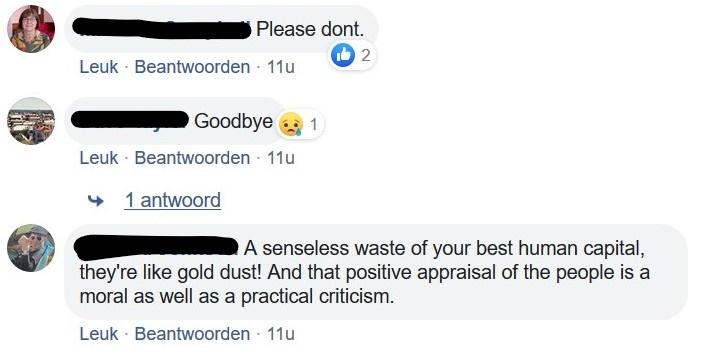
When looking at the response to the Global Hunger Strike, it is evident that the issue was one that resonated with many people, but they were divided when it came to the way this should be addressed and how the fight should be fought. The controversy around the movement thereby seems to have manifested itself also in this campaign.
Was the campaign successful?
It is hard to say what the consequences of the XR Global Hunger Strike are going to be in the long run. Although XR has made a post stating it was a success, the campaign does not seem to have been taken up by mainstream media. The responses to the strike were also quite negative, with some people stating that they can’t support XR anymore since they went forward with this action. Despite these seemingly meager results, some people are continuing the hunger strike. Some will only stop when their government meets their demands and XR UK is going to continue at least until the elections. This shows that, even though the message of protestors across the world is united on this Facebook page, the actions they take and the responses of governments differ per country. This makes it hard to say whether the XR Global Hunger Strike was a success, but the consequences seem a little underwhelming, and public opinion about it was quite negative from the start.
XR used Facebook for organizing and sharing updates about their Global Hunger Strike. They tried to spread their message of urgency and danger by choreography of assembly, specifically by creating a Facebook event with all the information one needs to participate in the Global Hunger Strike. Through their understanding of the affordances of Facebook, they tried to spread their message strategically, thereby using the platform at least to some extent for algorithmic activism.
The XR Global Hunger Strike did not fare well with a lot of XR’s following and it constituted yet another controversial move of the radical activist movement. Only time can tell whether their drastic actions will have helped or hurt the cause.
References
Gerbaudo, P. (2014). Tweets and the Streets. Social media and contemporary activism. London: Pluto Press.
Extinction Rebellion, (2019). This Is Not A Drill. An Extinction Rebellion Handbook. Penguin Books.
Silverstein, M. (2003). Talking Politics: The Substance of Style from Abe to "W". Chicago: Prickly Paradigm Press.
